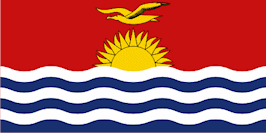Kiribati - History
 The I-Kiribati people settled what would become known as the Gilbert Islands between 1000 and 1300 AD. Subsequent invasions by Fijians and Tongans introduced Melanesian and Polynesian elements to the Micronesian culture, but extensive intermarriage has produced a population reasonably homogeneous in appearance and traditions.
The I-Kiribati people settled what would become known as the Gilbert Islands between 1000 and 1300 AD. Subsequent invasions by Fijians and Tongans introduced Melanesian and Polynesian elements to the Micronesian culture, but extensive intermarriage has produced a population reasonably homogeneous in appearance and traditions.
The European discovery of the atolls which make up Kiribati lasted almost three centuries — from the 16th through the 19th centuries. The Russian travellers F. F. Bellinsgauzen, I. F. Kruzenshtern and others made notable contributions to their study. The native population of the archipelago has withstood many trials and hardships. In the second half of the 19th Century, white traders by trickery or simply by force took 9,000 residents of Gilbert Islands for work on the plantations in Fiji, Queensland (Australia), the Hawaiian Islands, and Central America. Almost all of them perished, unable to endure the harsh exploitation, mockery and beatings by the overseers. Whalers, slave traders, and merchant vessels arrived in great numbers in the 1800s, fomenting local tribal conflicts and introducing often-fatal European diseases. Their acquaintance with the "civilized world" was accompanied by the spread of numerous diseases against which the islanders had no immunity.
In an effort to restore a measure of order, the Gilbert and Ellice Islands (the Ellice Islands are now the independent country of Tuvalu) consented to becoming British protectorates in 1892. Banaba (Ocean Island) was annexed in 1900 after the discovery of phosphate-rich guano deposits. In 1916 England annexed a large portion of the islands in the archipelago, including Ellis Island. Thus, the colony of Gilbert and Ellis Island was formed. The Line and Phoenix Islands were incorporated piecemeal over the next 20 years. Over a number of years other atolls were administratively joined to it, including Ocean Island (currently Banaba) and Christmas Island.
In 1938, the Americans occupied the islands of Canton and Enderbury of the Phoenix group, which is today a component part of Kiribati. They were attracted by the advantageous geographic position of the small pieces of dry land lying half-way between Hawaii and New Caledonia. The US government motivated its aspirations by the fact that in the mid-19th Century the American company Phoenix, which engaged in guano trade.
Difficult travails befell the islanders in the years of World War II. Several days after the attack on Pearl Harbor, the Japanese bombed Tarawa, and then captured Gilbert and Ocean Islands. The airborne assault operation conducted by the allied forces in the liberation of Tarawa was one of the most famous in the course of combat operations in the Pacific. The Japanese occupation forces took part of the residents and mine workers from Ocean Island to the islands of Nauru and Kusaye, and totally annihilated the rest. Only one man was miraculously saved, and after the war he spoke out as a witness at the trial of the Japanese war criminals.
In November 1943, U.S. forces assaulted heavily fortified Japanese positions on Tarawa Atoll in the Gilberts, resulting in some of the bloodiest fighting of the Pacific campaign. The battle was a turning point for the war in the Central Pacific.
In 1956-1958 the British, and in 1962 thfe Americans conducted testing of thermonuclear weapons on Christmas Island. Operation DOMINIC I was a series of 36 atmospheric nuclear detonations conducted in the PacificOcean from April to November 1962. Along with the continental DOMINIC II tests, these were the last atmospheric nuclear tests conducted by the United States. Most of the DOMINIC I test shots were detonated in the air after being dropped from a B-52 bomber. Twenty-four of the airdrops took place from April 25 through July 11 over the ocean just south of Christmas Island, a United Kingdom possession located 1,200 nmi (2,224 km) south of Honolulu, Hawaii. Because all but one of the shots were airbursts, there was little or no fallout and no residual radiationaround surface zero.
Britain began expanding self-government in the islands during the 1960s. In 1975 the Ellice Islands separated from the colony and in 1978 declared their independence. The Gilberts obtained internal self-government in 1977, and became an independent nation on July 12, 1979, under the name of Kiribati.
Formally greeting Kiribati's granting of independence, and even concluding a friendship agreement with the newly created state in September of 1979, the USA up to 1983 did not confirm its departure from certain islands which were part of Kiribati, specifically Canton and Enderbury. In 1979 the USA tried to buy Palmir Island from Kiribati for stockpiling nuclear weapons. The energetic intervention of the South Pacific Forum hindered the closure of this deal.
Post-independence politics were initially dominated by Ieremia Tabai, Kiribati's first President, who served from 1979 to 1991, stepping down due to Kiribati's three-term limit for presidents. The tenure of Teburoro Tito, Kiribati's second-longest serving President, was from 1994 to 2003. His third term lasted only a matter of months before he lost a no confidence motion in Parliament. (See the next section for an explanation of Kiribati's unique presidential system.) In July 2003, Anote Tong defeated his elder brother, Harry Tong, who was backed by former President Tito and his allies. Tong was re-elected for a second term as president in October 2007, and most recently defeated candidates Tetaua Taitai and Rimeta Beniamina to win a third term as president in January 2012.
|
NEWSLETTER
|
| Join the GlobalSecurity.org mailing list |
|
|
|

